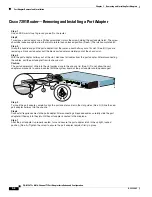
4-6
PA-MC-2T3+ Multi-Channel T3 Port Adapter Installation and Configuration
OL-3526-05
Chapter 4 Configuring Unchannelized mode for the Cisco PA-MC-2T3+
Configuring an Unchannelized T3 Link
Setting the Framing Type for the Serial Interface
In interface configuration mode, specify T3 framing by entering the
{c-bit | m13}
configuration
subcommand, as in the following example:
router(config-if)#
framing {c-bit | m13}
where:
•
c-bit
—C-bit parity DS3 framing
•
m13
—M13 Multiplex DS3 framing
Use the
no
form of this command to return to the default, C-bit framing.
Specifying the Cable Length for the Serial Interface
At the prompt, specify the cable length using the interface command
:
cablelength
feet
where:
•
feet
is a numeral from 0 to 450.
•
The default value is 10 feet.
An example follows:
Router(config-if)#
cablelength 40
Note
For the
cablelength
feet
command, user-specified T3 cable lengths are structured into ranges as follows:
0–49 and 50–450 to represent short and long cables.
If the numerical value entered by the user falls within the lower range, then the PA-MC-2T3+ T3 port is
set for short cable output levels. If the value falls into higher range, the long cable output levels will be
used.
In the preceding example, a cable length of 40 is specified, which means that the 0–49 range is used. If
you change the cable length to 45, then the 0–49 range still applies. Further, if you specify a cable length
of 100 or 200, the 50–450 range applies in both cases. Only moving from one range (0–49) to the other
range (50–450) has an effect. The actual cable-length number you enter is stored in the configuration
file. It is recommended that the actual cable length be entered to ensure future compatibility.
Setting the Clock Source for the Serial Interface
At the prompt, set the internal or line clock source for the selected T3 controller with the interface
command:
clock source
{
line
|
internal
}
Where:
line
—selects a network clock source
internal
—selects an internal clock source
The default is clock source internal.
















































